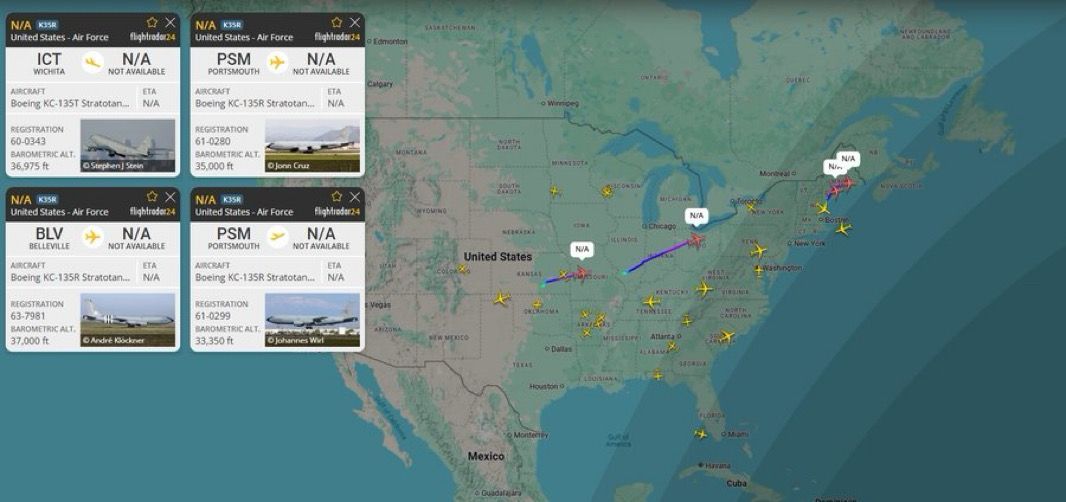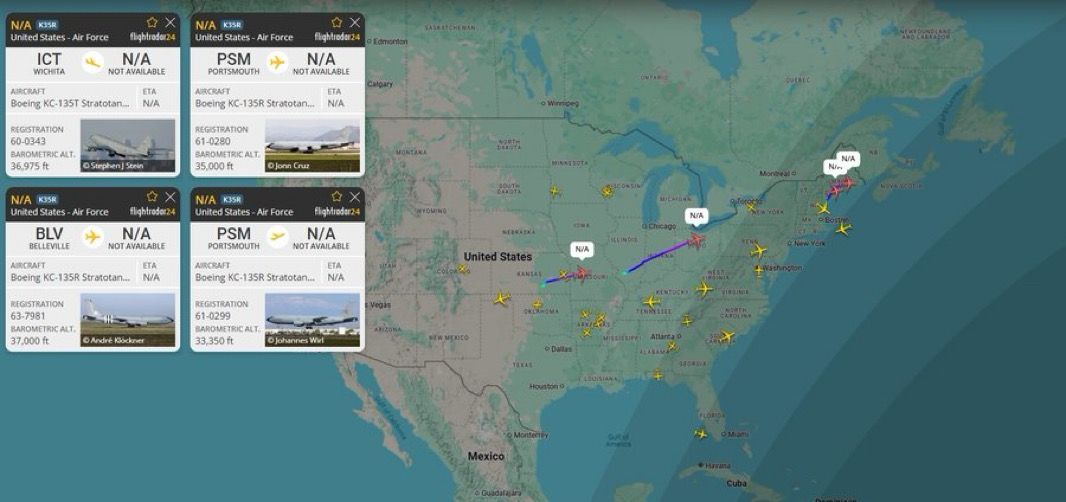U.S. AIR FORCE TANKERS HEAD EAST: WAR DRUMS OR STRATEGIC MOVE?
Breaking news: U.S. Air Force Deploys More Aerial Refueling Tankers
In a significant military development, multiple U.S. Air Force aerial refueling tankers, specifically the KC-135 and KC-46, have recently been launched from various stateside bases, heading eastward across the Atlantic. This move, reported within the last hour, follows the prepositioning of similar assets the previous day, signaling a potential escalation in military readiness and operations.
The Importance of Aerial Refueling
Aerial refueling is a critical capability for modern military operations, allowing aircraft to extend their range and stay airborne for longer periods without needing to land. The KC-135 Stratotanker, a veteran of the U.S. Air Force, has been in service since the 1950s. It plays a crucial role in supporting a variety of missions, including strategic bomber operations, airlift missions, and fighter support. The more recent KC-46 Pegasus brings advanced technology and capabilities, enhancing the Air Force’s ability to project power globally.
Context of the Deployment
This latest deployment comes amidst rising tensions in various regions around the world, particularly in Eastern Europe and the Middle East. The movement of these tankers may be a response to evolving geopolitical dynamics, including increased military activity from potential adversaries. By positioning these refueling assets closer to potential operation zones, the U.S. military can ensure that its aircraft are prepared for any urgent missions that may arise.
Previous Prepositioning Efforts
The prepositioning of similar aerial refueling assets just a day prior indicates a well-coordinated strategy by the U.S. military to maintain operational flexibility. Such proactive measures are essential for ensuring that the U.S. Air Force can respond swiftly to emerging threats or crises, reinforcing the nation’s commitment to its allies and maintaining stability in volatile regions.
- YOU MAY ALSO LIKE TO WATCH THIS TRENDING STORY ON YOUTUBE. Waverly Hills Hospital's Horror Story: The Most Haunted Room 502
Implications for U.S. Military Strategy
The deployment of these tankers highlights the U.S. military’s ongoing commitment to readiness and deterrence. By ensuring that refueling capabilities are available near potential conflict zones, the Air Force can support a wide range of operations, from humanitarian missions to combat operations. This flexibility is crucial in a rapidly changing global security environment.
Public and International Reaction
Reactions to this deployment are likely to vary. Supporters of a strong military presence may view this as a necessary step to protect national interests and support allies. Conversely, critics may express concerns about escalating tensions and the potential for conflict. Internationally, U.S. allies may interpret this move as a reassurance of support, while adversaries may see it as a provocation, potentially leading to increased military posturing on both sides.
Conclusion
The recent launch of U.S. Air Force KC-135 and KC-46 aerial refueling tankers marks a significant moment in the current military landscape. As these aircraft head eastward across the Atlantic, they underscore the importance of readiness in the face of evolving global challenges. The ability to refuel aircraft in flight enhances operational capabilities, allowing the U.S. military to maintain a strategic advantage. As developments unfold, it will be crucial to monitor the implications of this deployment for both U.S. military strategy and international relations.
This situation serves as a reminder of the complex interplay between military readiness and global diplomacy, and the role that aerial refueling plays in maintaining U.S. operational capabilities across the world.

BREAKING: MORE U.S. AIR REFUELING TANKERS LAUNCH EASTWARD
Multiple U.S. Air Force KC-135 and KC-46 aerial refueling tankers have taken off from stateside bases within the past hour, heading northeast across the Atlantic.
This follows yesterday’s prepositioning of similar… https://t.co/TubGWUt6lT pic.twitter.com/fRskiiBF7x
— Mario Nawfal (@MarioNawfal) June 17, 2025
BREAKING: MORE U.S. AIR REFUELING TANKERS LAUNCH EASTWARD
In a notable move that has caught the attention of defense analysts and military enthusiasts alike, multiple U.S. Air Force aerial refueling tankers, specifically the KC-135 and KC-46, have taken off from various bases across the United States. These aircraft are now heading northeast over the Atlantic Ocean, indicating a significant operational shift. As tensions rise globally, the deployment of these tankers is crucial for extending the reach of U.S. military operations.
Understanding the Aerial Refueling Capability
Aerial refueling is a game changer in modern warfare. It allows military aircraft to remain airborne longer without returning to base for fuel. This capability not only maximizes the operational range of fighter jets but also enhances the effectiveness of long-range missions. The KC-135 Stratotanker, a veteran of the skies since the 1950s, has been a reliable workhorse for the U.S. Air Force. On the other hand, the newer KC-46 Pegasus brings cutting-edge technology and improved fuel transfer capabilities to the table.
For those curious about how aerial refueling works, it’s quite fascinating. The tanker aircraft flies alongside the receiving aircraft, and a refueling boom extends to transfer fuel. This process requires precision and skill from both the pilots and the crew involved. The seamless coordination during this operation is vital for mission success, especially in high-stakes environments.
Recent Developments and Strategic Implications
The recent takeoff of these tankers follows yesterday’s prepositioning of similar aircraft, which indicates a strategic response to current global events. With rising tensions in various regions, particularly in Eastern Europe, the U.S. military is positioning itself to ensure readiness and rapid response capabilities. This kind of military posture sends a clear message of deterrence to potential adversaries.
Moreover, the deployment of these tankers can be seen as part of a broader strategy to enhance NATO’s collective defense efforts. As allies coordinate their military capabilities, the U.S. air refueling tankers play a pivotal role in ensuring that forces can operate effectively across the Atlantic and beyond.
The Role of KC-135 and KC-46 in Modern Warfare
The KC-135 has a storied history, having served in numerous conflicts over the decades. Its reliability has made it a staple in the U.S. Air Force’s aerial refueling fleet. However, the introduction of the KC-46 Pegasus marks a significant upgrade. With advanced avionics, improved fuel delivery systems, and the ability to refuel a wider range of aircraft, the KC-46 is designed to meet the demands of modern warfare.
With the KC-46, the Air Force can refuel not just traditional fighters but also unmanned aerial vehicles (UAVs) and bombers. This flexibility is crucial in a rapidly changing battlefield where adaptability can make all the difference. The combination of both tankers ensures that U.S. forces maintain a tactical edge.
The Strategic Importance of Aerial Refueling
So, why is aerial refueling so important? It’s all about maintaining air superiority and operational flexibility. Imagine a scenario where U.S. forces are engaged in a conflict far from home. Without aerial refueling, fighter jets would be limited in how long they could stay in the air, reducing their effectiveness in combat. By extending their flight time, refueling tankers allow these aircraft to conduct prolonged missions, providing support when and where it’s needed most.
Additionally, the ability to refuel at a moment’s notice enhances the U.S. military’s ability to respond to crises rapidly. Whether it’s a humanitarian mission or a combat operation, having the flexibility to extend the operational capabilities of aircraft is invaluable.
Global Reactions to the Deployment
The news of the U.S. air refueling tankers launching eastward has sparked reactions from various quarters. Military analysts are closely monitoring the situation, speculating on the potential implications for international relations and regional stability. Countries that may perceive this deployment as a threat could respond with heightened military readiness or diplomatic efforts to address their concerns.
Social media platforms are abuzz with discussions surrounding this development. Many users are sharing their thoughts, with some expressing support for the U.S. military’s readiness, while others raise concerns about escalating tensions. It’s a reminder of how interconnected our world is and how military actions can impact global perceptions.
Looking Ahead: What This Means for U.S. Military Operations
As the U.S. continues to navigate complex international landscapes, the deployment of air refueling tankers is likely to play a central role in future military strategies. The ability to project power globally while ensuring that air forces can operate effectively is paramount. With the KC-135 and KC-46 in action, the U.S. Air Force is well-positioned to respond to a variety of scenarios.
Furthermore, this deployment highlights the importance of maintaining a robust and responsive military infrastructure. As global challenges evolve, so too must the strategies employed by the U.S. and its allies. The emphasis on aerial refueling capabilities is just one aspect of a multifaceted approach to national defense.
Conclusion: The Future of Aerial Refueling
In a world where military readiness is crucial, the role of aerial refueling tankers cannot be overstated. The recent launch of U.S. Air Force KC-135 and KC-46 tankers heading eastward is a clear indication of the military’s commitment to maintaining a strong presence and readiness in response to global challenges. As we move forward, the advancements in aerial refueling technology and the strategic deployment of these assets will continue to shape the landscape of modern warfare.
Whether you’re a military enthusiast or simply someone interested in global affairs, keeping an eye on these developments is essential. The implications of these actions extend beyond the military realm, influencing diplomatic relations and international stability. With the world constantly evolving, the U.S. military’s ability to adapt and respond will remain a critical factor in shaping the future of global security.

